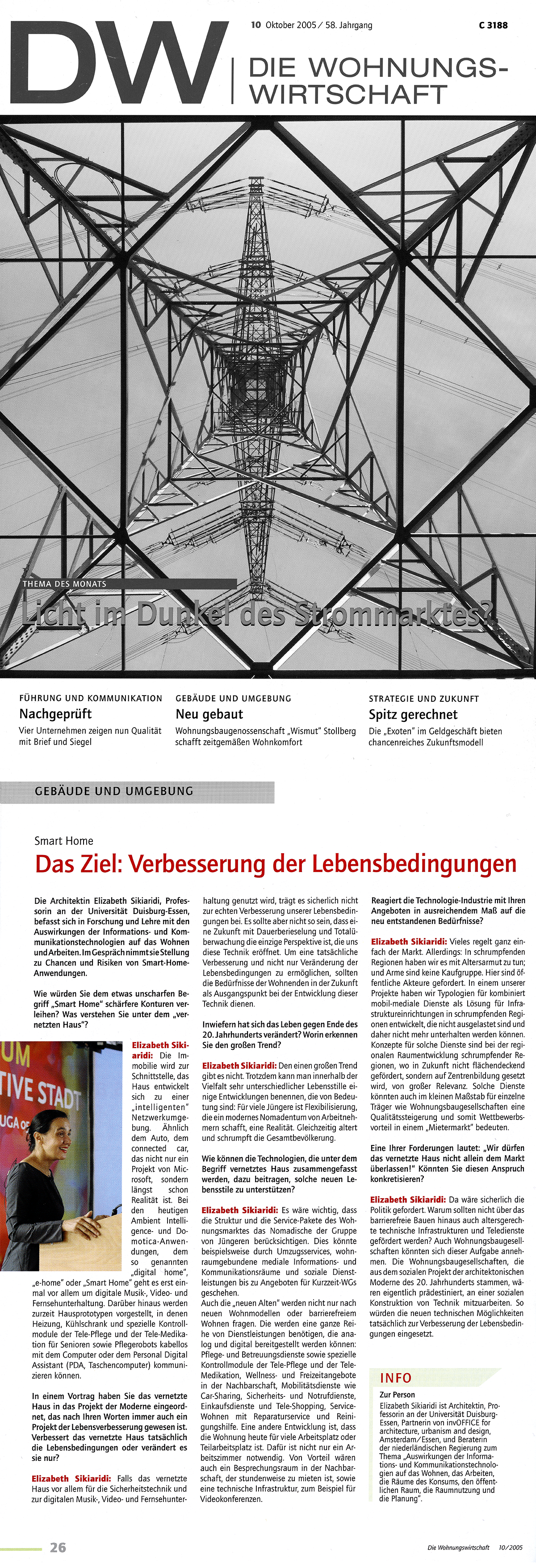Architect Elizabeth Sikiaridi, professor at the University of Duisburg-Essen, researches and teaches the effects of information and communication technologies on living and working.
In this interview, she comments on the opportunities and risks of smart home applications.
Publication Smart Home @ Die Wohnungswirtschaft, Germany, 1 October 2005
Smart
Home
The goal:
improving
living
conditions
Elizabeth Sikiaridi:
The property is becoming an interface, the house is developing into an “intelligent” network environment.
Similar to the car, the connected car, which is not just a Microsoft project but has long been a reality. Today’s ambient intelligence and domotica applications, the so-called “digital home”, “e-home” or “smart home”, are primarily concerned with digital music, video and television entertainment. In addition, home prototypes are currently being presented in which the heating, refrigerator and special control modules for telecare and telemedication for senior citizens as well as care robots can communicate wirelessly with the computer or personal digital assistant (PDA, pocket computer).
Elizabeth Sikiaridi:
If the connected home is mainly used for security technology and for digital music, video and TV entertainment, it certainly doesn’t contribute to the real improvement of our living conditions. But it shouldn’t be the case that a future of constant streaming and total surveillance is the only prospect that this technology offers us. In order to enable a real improvement and not just a change in living conditions, the needs of those living in the future should serve as the starting point for the development of this technology.
Elizabeth Sikiaridi:
There is no one big trend. Nevertheless, within the diversity of very different lifestyles, we can identify some developments that are significant: For many younger people, flexibilization, which creates a modern nomadic workforce, is a reality. At the same time, the overall population is ageing and shrinking.
Elizabeth Sikiaridi:
It would be important that the structure and service packages of the housing market take into account the nomadic nature of the younger age group. This could be done, for example, through relocation services, media information and communication spaces linked to the living space, social services and offers for short-term shared flats.
The “new elderly” will also not only ask for new housing models or barrier-free living. They will need a whole range of services that can be provided in analog and digital form:
Nursing and care services as well as special tele-care and tele-medication control modules, wellness and leisure activities in the neighborhood, mobility services such as car sharing, security and emergency call services, shopping services and tele-shopping, serviced living with repair services and cleaning assistance. Another development is that the home is now a workplace or part-time workplace for many people. This requires more than just a study. A meeting room in the neighborhood that can be rented by the hour and a technical infrastructure, for example for video conferencing, would also be an advantage.
Elizabeth Sikiaridi:
A lot of things are simply regulated by the market. However, in shrinking regions, we are dealing with poverty among the elderly, and the poor are not a purchasing group. This is where public actors are called upon. In one of our projects, we have developed typologies for combined mobile-media services as a solution for infrastructure facilities in shrinking regions that are underutilized and can therefore no longer be maintained.
Concepts for such services are of great relevance in the regional spatial development of shrinking regions, where in future the focus will be on centers of education rather than nationwide funding. Such services could also mean an increase in quality on a small scale for individual providers such as housing associations and thus a competitive advantage in a “tenants’ market”.
Elizabeth Sikiaridi:
That would certainly be a challenge for politicians. Why shouldn’t age-appropriate technical infrastructure and teleservices be promoted in addition to barrier-free construction? Housing associations could also take on this task. Housing associations, which originate from the social project of 20th century architectural modernism, were actually predestined to work on the social construction of technology. In this way, the new technical possibilities could actually be used to improve living conditions.
related PRESS
